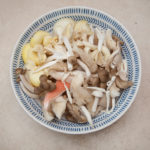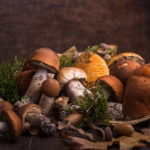By David Blyweiss, M.D., Advanced Natural Wellness
December 27, 2017
- Here’s a new nutrient to add to your vocabulary
- The incredible medicinal mushroom
- Eating more mushrooms is this easy
If you keep up on health news, there is always a new and seemingly unpronounceable nutrient to add to your vocabulary, like pterostilbene or cholecalciferol.
Today I have one you might not have heard before… one that you should write down and remember.
It’s ergothioneine (pronounced urr-go-thigh-in-in). For short, you can call it ergo.
The reason it’s important for you to remember ergothioneine is because it’s a DNA protector for our cells and powerful antioxidant that’s concentrated in your mitochondria. Your mitochondria power every cell in your body with energy.
But as you age, mitochondria become damaged. They mutate and can’t produce energy as well as they used to. And as the efficiency of these old mitochondria drops, so does their ability to power up your brain and body. Damaged mitochondria are linked to cancer, neurodegenerative diseases and other health concerns.
Well, here’s the big news.
Ergothioneine (ergo) has both age-defying and chemo-protective qualities that can power up your mitochondria for life-long health and energy. It’s a powerful free radical scavenger, anti-inflammatory and protects against radiation. It also acts as a chelation agent against heavy metals such as mercury and cadmium.
However, your body doesn’t produce ergo on its own. There is only one way you can get more of it and experience the health effects it offers.
The Incredible Medicinal Mushroom
If you want to get the superior antioxidant protection that ergo offers, you only have to do one thing; eat more mushrooms.
That’s right. Mushrooms are, by far, the most abundant source of ergo in our food supply. In fact, some types of mushrooms can contain concentrations up to 40 times higher than the second best food source of it.
Eating just 3.5 ounces of white button mushrooms daily for just 16 weeks can double your levels of ergo. And here’s the thing, out of all the mushrooms we eat, the ones we know as white button have the lowest ergo content (but still have higher amounts than most other foods).
So just imagine how much more of this antioxidant you would get if you ate the mushrooms with the highest ergo content, like porcini’s or portabella’s, on a daily basis.
The World's Quickest Solution for Ending Prostate and Urinary Misery
This has recently been revealed to be one of the only real breakthroughs in prostate health.
The seeds of a strange fruit (sometimes called "Chinese Apples") hold powerful phytonutrients that are a revolution in prostate health.
In fact, UCLA and Veterans Administration research have now proved this to be true.
Not only that, but it may be the worlds quickest solution for ending prostate misery.
Simply stated, these phytonutrients represent a huge step beyond beta sitosterol, saw palmetto, and other phytosterols alone.
Simply click HERE if you want to have fast prostate relief...restful, uninterrupted sleep...no more constant "urges to go"...enhanced virility...and optimal prostate support for life.
I know one thing. Every time I savor a few stuffed mushrooms or a grilled Portobello, I’m getting a hefty dose of this highly absorbable nutrient. And it goes to work immediately to improve the bacterial diversity of my gut microbiota, support my immune function, protect my cognitive health and even help to manage my weight.
All of this is on top of the mitochondrial-saving and cancer-fighting benefits.
Eating More Mushrooms is as Easy as This
You can add mushrooms to almost anything you eat… or you can center an entire meal around them.
Stuffed mushrooms are a given. I like to make a mixture of crabmeat and chopped shrimp with some minced onion, celery and garlic to stuff mine with. It’s a healthier alternative than the standard fare of using bread crumbs topped with cheese.
I’m also a big fan of Portobello mushroom steak. It’s basically a giant grilled or broiled Portobello mushroom cap. You can top it with anything you want. I like mine with tomatoes, onions, olive oil, spinach and garlic.
Use mushrooms as a salad topping or sandwich garnishes. Add them to your soups and stews. Serve marinated or sautéed mushrooms with your wild-caught fish, grass-fed beef or pasture-raised poultry. Slice them up and put them in your sauces and dips.
It’s as easy as that!
SOURCES:
Paul BD, et al. The unusual amino acid l-ergothioneine is a physiologic cytoprotectant. Cell Death Differ. 2010 Jul; 17(7): 1134–1140.
Cheah IK, et al. Ergothioneine; antioxidant potential, physiological function and role in disease. Biochim Biophys Acta. 2012 May;1822(5):784-93.
Calvo MS, et al. A Retrospective Study in Adults with Metabolic Syndrome: Diabetic Risk Factor Response to Daily Consumption of Agaricus bisporus (White Button Mushrooms). Plant Foods Hum Nutr. 2016 Sep;71(3):245-51.
Feeney MJ, et al. Mushrooms and Health Summit proceedings. J Nutr. 2014 Jul;144(7):1128S-36S.







